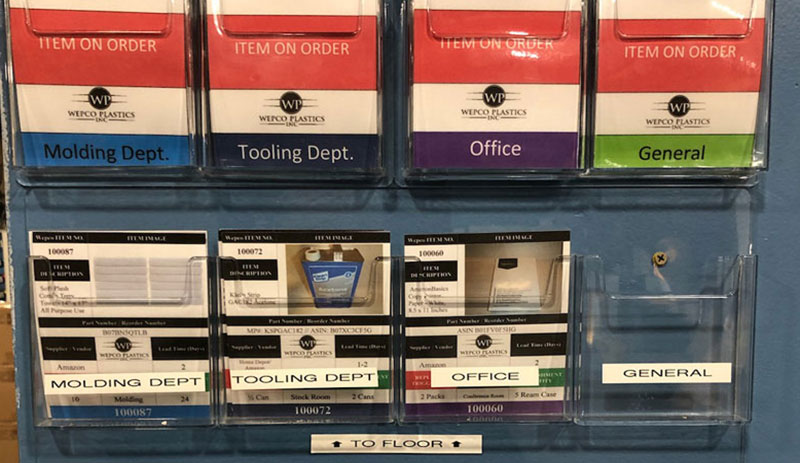by Ashley Turrell, membership & analytics director
MAPP
Oftentimes, when organizations think about major improvement ideas, these ideas come with a major price tag. And while the opportunities for improvements in automation and Industry 4.0 continue to grow, it is important that organizations also remember the basics.
Below are four examples of simple improvements implemented by plastics companies that came without the need for major capital investment, but made a big impact on their processes, their teams, their products and their organizations. From safety and training to workstations and lean, these are no-fluff, straight-forward, actionable ideas that can be adapted and formulated to work for organizations of all sizes and industries.
Cosmetic Specialties International (CSI) – CNC Operator Workstation
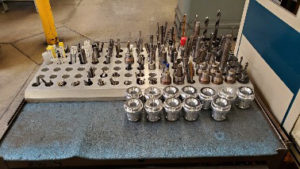 “We created a workstation for our CNC operators in order to reduce time searching for mill tooling and to put all critical functions together in an organized manner. We now can track the work being done from start to finish,” shared Cosmetic Specialties International’s (CSI) executive vice president and COO Chris Gedwed. The organization, which operates out of Oxnard, California, specializes in cosmetic packaging for the beauty and skin care industries.
“We created a workstation for our CNC operators in order to reduce time searching for mill tooling and to put all critical functions together in an organized manner. We now can track the work being done from start to finish,” shared Cosmetic Specialties International’s (CSI) executive vice president and COO Chris Gedwed. The organization, which operates out of Oxnard, California, specializes in cosmetic packaging for the beauty and skin care industries.
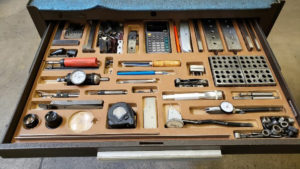 “CNC operators were wasting time constantly searching for their tool kits, the correct fixtures and tools for a job,” noted Gedwed. To increase efficiency and reduce wasted motion and time, CSI dedicated time to create a workstation that was practical and functional. The workstation was created from a repurposed tool cart and is on wheels, so the workstation itself is mobile. The mobile CNC workstation includes a bench vise, hand tapper and electronic buffer. Additionally, the top of the cart has room for operators to actually work on items, along with two levels of storage.
“CNC operators were wasting time constantly searching for their tool kits, the correct fixtures and tools for a job,” noted Gedwed. To increase efficiency and reduce wasted motion and time, CSI dedicated time to create a workstation that was practical and functional. The workstation was created from a repurposed tool cart and is on wheels, so the workstation itself is mobile. The mobile CNC workstation includes a bench vise, hand tapper and electronic buffer. Additionally, the top of the cart has room for operators to actually work on items, along with two levels of storage.
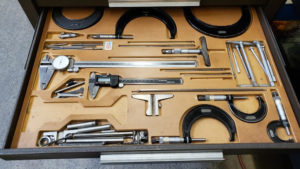 Along with the mobile workstation, CSI created a standardized tool box so tools, which are arranged by type, are easy to find. All measuring instruments have a unique slot for easy access – this also makes it easy to notice if one tool is missing. The toolbox has custom aluminum cutting tool holders for the CNC mill. The top of the toolbox acts as the workstation, while each drawer has a designated function: top drawer for tools needed to set ups on the mill and the second drawer for holding measuring instructions, such as caliper and micrometers, etc.
Along with the mobile workstation, CSI created a standardized tool box so tools, which are arranged by type, are easy to find. All measuring instruments have a unique slot for easy access – this also makes it easy to notice if one tool is missing. The toolbox has custom aluminum cutting tool holders for the CNC mill. The top of the toolbox acts as the workstation, while each drawer has a designated function: top drawer for tools needed to set ups on the mill and the second drawer for holding measuring instructions, such as caliper and micrometers, etc.
Overall, CSI notes that this improvement helped the company reduce wasted time and increase the productivity of its tool room.
Wepco Plastics – Inventory Kanban Cards
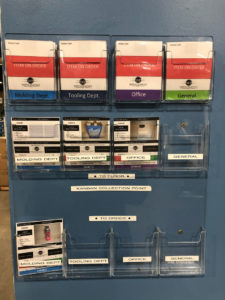 When Wepco Plastics began evaluating opportunities for lean improvements, the company looked for the everyday things that caused headaches. One of the improvements, implemented by Kyle Tew, Wepco’s value stream manager, came in the form of Inventory Kanban Cards. Wepco Plastics, which operates out of Middlefield, Connecticut, specializes in production-quality prototype tooling.
When Wepco Plastics began evaluating opportunities for lean improvements, the company looked for the everyday things that caused headaches. One of the improvements, implemented by Kyle Tew, Wepco’s value stream manager, came in the form of Inventory Kanban Cards. Wepco Plastics, which operates out of Middlefield, Connecticut, specializes in production-quality prototype tooling.
“We saw the need for standardized inventory Kanban cards because we were running out of supplies. When we would reorder, we would use different suppliers with varying lead times and prices for similar items. For example, we would order basic packaging tape from three different companies. The quality of the items also would vary,” stated Tew.
The company decided to inventory every common consumable (i.e. items the company uses almost daily) in the facility and select preferred vendors. From there, a master list of information was created and then transferred to the Kanban cards. This includes the supplier, when supplies need to be replenished, where it is located in the facility, lead time and how much to order to replenish the inventory.
The Kanban cards themselves are attached to the point of use for storage for that particular item via Velcro stickers. Then, when an employee retrieves an item that is running low, the employee is signaled that it is time to reorder. The employee removes the card and places it in the Kanban collection holder. The purchaser then notices the card and places an “Item on Order” card where the original Kanban card was removed. When the item comes in, the Kanban cards are placed back in their original space.
At any point in time when an item supply is low, any employee, regardless of department or job function, can take the Kanban card and place it in holder. This system has removed any confusion or frustration associated with supply inventory for the most commonly used items for the team.
Revere Plastics Systems, LLC – Operator in Training
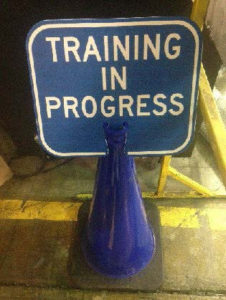 Everyone knows that right now training and retention, especially early on for a new hire, are key concerns for manufacturers. To help bring awareness to new hire on-boarding and training, Revere Plastics Systems in Clyde, Ohio, implemented a simple yet effective tool: a training cone. The cone itself is placed anywhere that a new hire is being trained. The cone, which has a sign reading “Training in Progress,” serves multiple purposes.
Everyone knows that right now training and retention, especially early on for a new hire, are key concerns for manufacturers. To help bring awareness to new hire on-boarding and training, Revere Plastics Systems in Clyde, Ohio, implemented a simple yet effective tool: a training cone. The cone itself is placed anywhere that a new hire is being trained. The cone, which has a sign reading “Training in Progress,” serves multiple purposes.
“We use this to indicate where a new hire is being placed; to help to clearly explain what may otherwise look to a passerby as an ‘extra employee’ or someone just standing around, when in fact they are being trained; to alert quality auditors that extra attention and inspection are needed here; and to promote and invite other employees and management to introduce themselves and offer encouragement and support, or simply welcome the new employee to the company,” shared Jeanne Vanyo, senior human resources manager.
Additionally, to bring new employees on board, the new hire is paired with a certified trainer. Each job book has a color-coded sticker on the cover and spine to indicate the skill level needed to perform that job: Green – low risk, minimum of eight hours of training before sign off; Yellow – medium risk, graduated from green based on evaluation, minimum of 24 hours of training before sign off; Orange – high risk, graduated from yellow based on evaluation, minimum of 48 hours of training before sign off; and Blue – special cause, such as quality issue or new job launch. New hires are initially placed on an entry level “green job,” and work with the trainer to be promoted to a new level.
This system has helped the organization on-board employees, ensure they are being trained on the right jobs and at the right skill level, and make them feel welcomed as they begin their journey with the company.
Dymotek – Emergency Flip Books
 Regardless of where you are located, disasters and emergencies can happen. Dymotek, an injection-molder out of Ellington, Connecticut, knows this and takes it to heart. At each of its two locations, there is an Emergency Flip Chart for employees and supervisors to reference during an emergency situation. The flip chart includes plans for potential emergencies, such as floods, workplace violence, gas leaks, severe weather, injury, power outages, etc.
Regardless of where you are located, disasters and emergencies can happen. Dymotek, an injection-molder out of Ellington, Connecticut, knows this and takes it to heart. At each of its two locations, there is an Emergency Flip Chart for employees and supervisors to reference during an emergency situation. The flip chart includes plans for potential emergencies, such as floods, workplace violence, gas leaks, severe weather, injury, power outages, etc.
The flip chart is color coded and has tabs for each situation. With each tab are instructions of what do in that type of situation. There are two flip charts in each facility, one on the production floor and one in the main office.
Supervisors, receptionists and senior team members are trained on these processes – not just by reviewing the manual, but by simulating actual emergencies.
“This is a living and breathing document,” explains Andrea DeForge, executive assistant at Dymotek. “We update it regularly with lessons learned.” One lesson learned is that for a recent emergency situation (tornado warning), the instructions were simply to “notify everyone in the building” – but didn’t say how.
When this was enacted in real time, it was found that one person wasn’t aware of what was happening because the supervisor simply gathered everyone in the office area to tell them. The document then was updated to explain exactly what should be done so that everyone in the building is notified.
The flip chart is updated frequently, and supervisors review it once a month to see any changes or updates that have been made. “This tool takes the guesswork out of what to do in an emergency,” says DeForge. This simple tool has helped to make Dymotek safer in case of an emergency situation.
The Manufacturers Association of Plastics Processors (MAPP) annually creates books of best practices based on the policies and procedures implemented by its members. It is the hope of the association that plastics processors across the country can evaluate these ideas and put them into motion in their own facilities.
More information: www.mappinc.com

